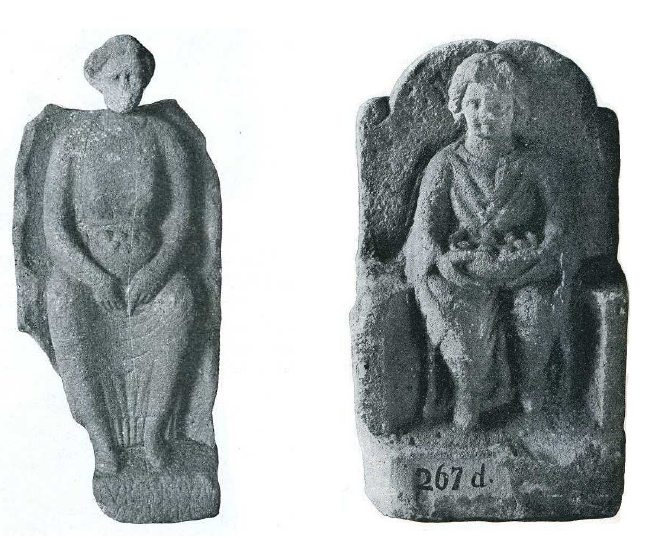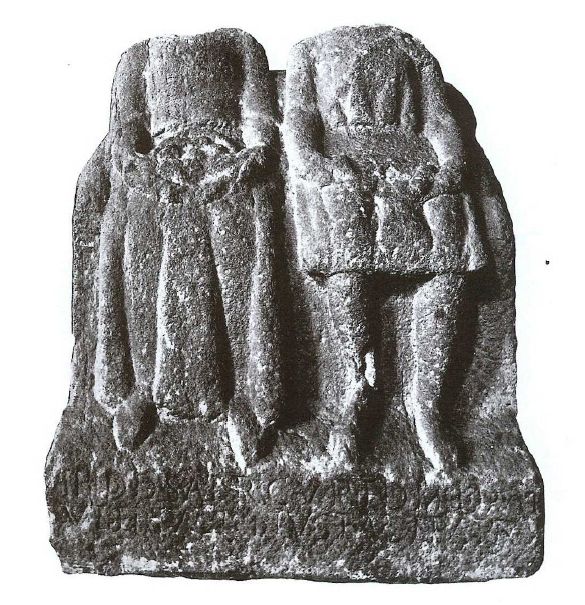E) Some remarks on Aericura
The spelling of this goddess name varies greatly: Aericura, Aerecura, Erecura, Eracura, Ericura and Herecura. Her name, the meaning of which remains obscure, is probably not Celtic but Germanic. Delamarre however thinks she is Celtic and proposes to break it down as *Ēri-cūrā, ‘Wind of the West’.737 As far as Olmsted is concerned, the first element of her name eri- might be an intensive prefix meaning ‘to go beyond’, while the second element cura might come from the zero-grade of *kueru- signifying ‘grind, mill, flour’. According to him, Ericura would mean ‘Before the Bread’.738
However, the fact that her worship is concentrated to Southern Germany and the North-West of the Balkans would tend to prove that she is of Germanic origin.739 She is mentioned in inscriptions from Mainz, Sulzbach, Stockstadt, Monterberg, Xanten, Iversheim, Cannstatt, Mautern, (Germany), Beetgum and Holledorn (the Netherlands), Langres (Haute-Marne), Belley (Ain), Rome, Aquileia and Perugia740 (Italy), Verespatak (Romania) and Announa (Thibilis) in Numidia (present-day Algeria), which was a Roman province. Scholars sometimes relate her to the god Arecurius, honoured in an inscription from Corbridge (Northumbria, GB): Deo Arecurio. It must however be borne in mind that this inscription is quite uncertain, and it might be a misreading of Mercurio.741
Two of the inscriptions from Cannstatt are combined with a representation of the goddess. The first one portrays her draped and shod, sitting and holding a basket of fruit in her lap.742 The inscription, engraved at the bottom of her feet, reads: [Her]ecur(a)e sig(num) Val(erius) […] vslm (fig. 10).743 The other relief* is mutilated and only the bottom of it remains.744 The inscription is engraved under a seated goddess, who wears a dress and shoes and holds a basket of fruit on her knees: Herecur(a)e Cottus G[…]i (filius) ex voto suscepto posuit v(otum) s(olvit) l(ibens) l(aetus) m(erito).745 Aericura does not possess any distinctive attributes of her own. She is depicted merely with the attributes of fertility and does not distinguish herself from the iconography of the Matres and Matronae. Several other reliefs* of the same type, representing a similar seated goddess with shoes and basket of fruit were discovered in the area (fig. 10). This type might be figurations of Aericura but it could equally be portrayals of a single Mother Goddess.746

On a mutilated altar from Sulzbach, near Carlsruhe (Germany), discovered in 1813 in a cave, Aericura is represented seated beside the god Dis Pater, as the inscription engraved on the socle indicates: I(n) h(onorem) d(omus) d(ivinae) d(eae) s(anctae) Aericur(ae) et Diti Pat(ri) Veter(ius) Paternus et Adie(ctia) Pater(na) (fig. 11).747Their heads are now missing. The god wears a tunic and holds an object in his hands, possibly an unrolled scroll, while the goddess has a long robe and a tray of fruit in her lap.
As his name shows, Dis Pater (‘Father of Riches’)748 was originally a god of fertility and agriculture.749 He was later attached to the realm of the dead and became the Roman god of the Underworld. He is identical to Roman Pluto (‘the Rich’) and corresponds to the Greek Hades. Linckenheld and De Vries demonstrate that the distribution of Aericura and Dis Pater’s cult is complementary to the distribution of Nantosuelta and Sucellus’s worship.750 In other words, the areas of cult do not tally and thus complete one another. Lickenheld points out that the two divine couples must be emanations of one another, for they possess the same agrarian, chthonian* and funerary functions.751 As far as he is concerned, Ericura and Nantosuelta are one and the same divine character, like Sucellus and Dis Pater are the very same figure. Auguste Allmer and De Vries reject this view and argue convincingly that Dis Pater cannot be regarded as the equivalent of Sucellus, since he does not bear the same attributes, that is the hammer and the olla*.752 Moreover, Nantosuelta has an iconography specific to her which clearly distinguishes her from Aericura. Nevertheless, they probably share similar functions of prosperity and benevolence.
The agrarian attributes in her iconography clearly illustrate Aericura’s role of land-goddess. Her association with Dis Pater supports that idea, insomuch as this god was originally worshipped as a purveyor of riches. As Dis Pater was also the lord of the realm of the dead, Aericura might have been linked to death and endowed with a funerary aspect. Those various elements led Green and De Vries to compare her to the Roman goddess of the dead Hecate, who was originally a goddess dispensing fertility of the ground, luck and victory. They also parallel her with the Greek goddess Persephone, the equivalent of the Roman goddess Proserpina, who primarily presided over crops and the germination of plants before being partnered with Pluto and reigning over the Underworld.753 Those examples show that chthonian* goddesses were closely linked to death. This can be explained by the eternal cycle of nature which consists of birth, death and renewal. Finally, Aericura’s funerary dimension could be evidenced by the fact that reliefs* and inscriptions were discovered in cemeteries, such as in Cannstatt, or associated with funerary stones, for instance in Rottenburg.754

From this it follows that the faith in a goddess embodying the land is ancient and firmly fixed in tradition. According to the places and traditions, she took up various names referring to the earth, land, plain or field. On the Continent, there is evidence of the goddesses Litavi (‘Earth’), the Matres Mageiae (‘the Mother Goddesses of the Field?’), the Magiseniae (‘the Ancient Fields’) and Nantosuelta (‘Winding Brook’ or ‘Meadows’?) and in Ireland of Ériu (‘Land’), Tailtiu (‘Earth’ or ‘Plain’) and Macha (‘Field’). The personification of the land is, besides, well-illustrated in Irish medieval literature which sometimes depicts how the body of a goddess shapes the landscape. Moreover, some legends clearly stress the agrarian functions of the goddesses attached to the land, the most relevant examples being the Mórrígain ploughing her piece of land or Tailtiu dying of exhaustion after clearing the forests and digging the plain of Brega.